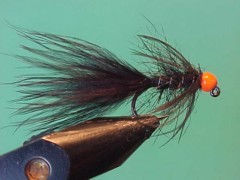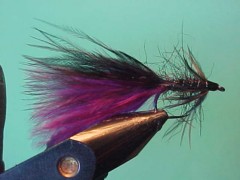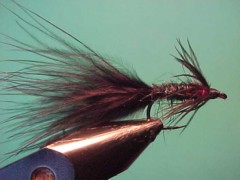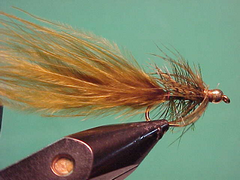My woolly bugger fly box
{{start}}
My first fish on fly fell to the magic of a Woolly Bugger and many have gone the same way since then.
My understanding is that the Woolly Bugger has its origins in America where it appears to be tied, as a leach imitation. having said that there is also an English fly with bead chin eyes called a Dog Nobler that is very similar to a traditional Woolly Bugger. Whatever the name or origin this style of fly is a great fish taker in a wide range of conditions. There are probably more variations to the Woolly Bugger than I have had breakfasts. Some are over-dressed some under-dressed, some weighted others not, on all sorts of hooks and in all sorts of colour combinations. Most will work sometimes but many are “once of” flies that don’t consistently take or attract fish.
I have tried out many over the years and now carry a range of Woolly Buggers that have specific applications. In each case they have a reason for being and they have been proven over time to take or attract fish.
My basic tie for a Woolly Bugger is similar to so many others. Having said that I do have a few quirky criteria that I strictly adhere to every time I tie a Woolly Bugger.
Throughout this web site I describe my woolly buggers according to size as set out in the following table:
MINI = approximately 20mm
SMALL = approximately 30mm
MEDIUM = approximately 40mm
STANDARD = approximately 50mm
LARGE = approximately 60mm
XL = approximately 70mm
{{end}}

{{+1}}River Jig Bugger – CDC orange TBH and black{{-1}}
{{start}}
This is really good representation of a woolly bugger for river fishing. It sinks well and the jig hook encourages the fly to bounce along the bottom hook point up which of course mitigates snags. Whilst I have set the recipe out below for the brown, black and olive jig buggers I also tie my sparkle bugger and skirted buggers in the form of a jig bugger as shown in the photos below.{{end}}

{{+1}}Tassi bugger – Chatto’s version{{-1}}
{{start}}
I was introduced to this variation in the lead up to the 2002 Tasmanian One Fly which by chance I won. Whilst I was not comfortable enough to use this fly in that contest I have used it many times since to great effect.{{end}}

{{+1}}Bibio bugger – Chatto’s original{{-1}}
{{start}}
There are a few flies that I have absolute confidence in and consequently have no hesitation in tying them on if I am in unknown territory and am up for a bit of prospecting. This fly is really a merging of two of them and it is so consistent that its has earned its own place amongst my top 10 or so trout flies. The two flies that were merged to form this fly were of course the bibio and the standard black woolly bugger. Whilst the bibio still holds its own place in my top 10 or so trout flies this bibio bugger has displaced the standard black woolly bugger.{{end}}

{{+1}}Mini woolly buggers{{-1}}
{{start}}
In recent years I have found that other than the traditional woolly bugger of around 50 mm in length there is also a demand for very small woolly buggers. In fact I would go as far as to say that in most of the fisheries that I haunt 'mini woolly buggers' of from 25 mm to 30 mm in length are often more effective than the larger versions on which they are based. I have narrowed down the mini woolly bugger selection that I carry to just brown, black, black with a red thread head and olive versions.{{end}}

{{+1}}Shrek – original{{-1}}
{{start}}
This fly was out of left field as far as I am concerned and when first introduced to it had no great expectation of it finding its way into my fly box. I was wrong. The bright tinsel body certainly stands out and rather than spooking fish as I expected it seems to trigger a response from trout particularly in “smelt” water or slightly discolored or tannin water.{{end}}

{{+1}}Woolly bugger{{-1}}
{{start}}
The Woolly Bugger is perhaps the quintessential streamer fly and has its origins in America ..... there is also an English fly with bead chin eyes called a Dog Nobler that is very similar. Whatever the name or origin this style of fly is a great fish taker in a wide range of conditions. There are probably more variations to the Woolly Bugger than I have had breakfasts. Some are over-dressed some under-dressed, some weighted other not, on all sorts of hooks and in all sorts of colour combinations. I carry black, brown and olive versions.{{end}}













